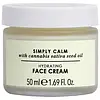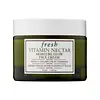What's inside
What's inside
 Key Ingredients
Key Ingredients

 Benefits
Benefits

 Concerns
Concerns

 Ingredients Side-by-side
Ingredients Side-by-side

Water
Skin ConditioningGlycerin
HumectantEthylhexyl Palmitate
EmollientButyrospermum Parkii Butter
Skin ConditioningPolyglyceryl-6 Distearate
EmulsifyingCannabis Sativa Seed Oil
EmollientCetyl Alcohol
EmollientCaprylic/Capric Triglyceride
MaskingStearic Acid
CleansingPhenoxyethanol
PreservativeVitis Vinifera Seed Oil
EmollientPanthenol
Skin ConditioningCarbomer
Emulsion StabilisingSodium Stearoyl Glutamate
CleansingCaprylyl Glycol
EmollientSodium Hyaluronate
HumectantAloe Barbadensis Leaf Juice
Skin ConditioningXanthan Gum
EmulsifyingEthylhexylglycerin
Skin ConditioningPotassium Hydroxide
BufferingSodium Phytate
Citrullus Lanatus Seed Oil
EmollientHexylene Glycol
EmulsifyingTocopherol
AntioxidantTetrahexyldecyl Ascorbate
AntioxidantLimonene
PerfumingHelianthus Annuus Seed Oil
EmollientLavandula Angustifolia Oil
MaskingCucumis Sativus Fruit Extract
EmollientTheobroma Cacao Extract
Skin ConditioningCitrus Nobilis Peel Oil
MaskingHyssopus Officinalis Flower/Leaf/Stem Oil
MaskingLinalool
PerfumingWater, Glycerin, Ethylhexyl Palmitate, Butyrospermum Parkii Butter, Polyglyceryl-6 Distearate, Cannabis Sativa Seed Oil, Cetyl Alcohol, Caprylic/Capric Triglyceride, Stearic Acid, Phenoxyethanol, Vitis Vinifera Seed Oil, Panthenol, Carbomer, Sodium Stearoyl Glutamate, Caprylyl Glycol, Sodium Hyaluronate, Aloe Barbadensis Leaf Juice, Xanthan Gum, Ethylhexylglycerin, Potassium Hydroxide, Sodium Phytate, Citrullus Lanatus Seed Oil, Hexylene Glycol, Tocopherol, Tetrahexyldecyl Ascorbate, Limonene, Helianthus Annuus Seed Oil, Lavandula Angustifolia Oil, Cucumis Sativus Fruit Extract, Theobroma Cacao Extract, Citrus Nobilis Peel Oil, Hyssopus Officinalis Flower/Leaf/Stem Oil, Linalool
Water
Skin ConditioningGlycerin
HumectantPentylene Glycol
Skin ConditioningEthylhexyl Isononanoate
EmollientPolyglyceryl-6 Stearate
EmollientPolyglycerin-3
HumectantCaprylic/Capric Triglyceride
MaskingJojoba Esters
EmollientPropanediol
SolventSodium Polyacrylate
AbsorbentEthylhexyl Palmitate
EmollientStearic Acid
CleansingCaprylyl Glycol
EmollientChlorphenesin
AntimicrobialPolyglyceryl-6 Behenate
Emulsion StabilisingAcrylates/C10-30 Alkyl Acrylate Crosspolymer
Emulsion StabilisingParfum
MaskingSodium Stearoyl Glutamate
CleansingTocopheryl Acetate
AntioxidantXanthan Gum
EmulsifyingTrisodium Ethylenediamine Disuccinate
Glucosyl Hesperidin
HumectantLimonene
PerfumingSodium Hydroxide
BufferingAscorbyl Tetraisopalmitate
AntioxidantPanthenol
Skin ConditioningSodium Hyaluronate
HumectantMagnesium Aspartate
Skin ConditioningZinc Gluconate
Skin ConditioningVaccinium Myrtillus Fruit Extract
Skin ConditioningLinalool
PerfumingCaramel
Cosmetic ColorantSaccharum Officinarum Extract
MoisturisingCopper Gluconate
Skin ConditioningCitral
PerfumingCitrus Aurantium Dulcis Fruit Extract
MaskingCitrus Limon Fruit Extract
MaskingTocopherol
AntioxidantAcer Saccharum Extract
Skin ConditioningWater, Glycerin, Pentylene Glycol, Ethylhexyl Isononanoate, Polyglyceryl-6 Stearate, Polyglycerin-3, Caprylic/Capric Triglyceride, Jojoba Esters, Propanediol, Sodium Polyacrylate, Ethylhexyl Palmitate, Stearic Acid, Caprylyl Glycol, Chlorphenesin, Polyglyceryl-6 Behenate, Acrylates/C10-30 Alkyl Acrylate Crosspolymer, Parfum, Sodium Stearoyl Glutamate, Tocopheryl Acetate, Xanthan Gum, Trisodium Ethylenediamine Disuccinate, Glucosyl Hesperidin, Limonene, Sodium Hydroxide, Ascorbyl Tetraisopalmitate, Panthenol, Sodium Hyaluronate, Magnesium Aspartate, Zinc Gluconate, Vaccinium Myrtillus Fruit Extract, Linalool, Caramel, Saccharum Officinarum Extract, Copper Gluconate, Citral, Citrus Aurantium Dulcis Fruit Extract, Citrus Limon Fruit Extract, Tocopherol, Acer Saccharum Extract
Ingredients Explained
These ingredients are found in both products.
Ingredients higher up in an ingredient list are typically present in a larger amount.
This ingredient is an emollient, solvent, and texture enhancer. It is considered a skin-softener by helping the skin prevent moisture loss.
It helps thicken a product's formula and makes it easier to spread by dissolving clumping compounds.
Caprylic Triglyceride is made by combining glycerin with coconut oil, forming a clear liquid.
While there is an assumption Caprylic Triglyceride can clog pores due to it being derived from coconut oil, there is no research supporting this.
Learn more about Caprylic/Capric TriglycerideCaprylyl Glycol is a humectant and emollient, meaning it attracts and preserves moisture.
It is a common ingredient in many products, especially those designed to hydrate skin. The primary benefits are retaining moisture, skin softening, and promoting a healthy skin barrier.
Though Caprylyl Glycol is an alcohol derived from fatty acids, it is not the kind that can dry out skin.
This ingredient is also used as a preservative to extend the life of products. It has slight antimicrobial properties.
Learn more about Caprylyl GlycolEthylhexyl Palmitate, also known as octyl palmitate, is created from 2-ethylhexyl alcohol and palmitic acid. It is a fatty acid ester.
The fatty acid content of Ethylhexyl Palmitate makes it an emollient. Emollients help soften and hydrate your skin by trapping moisture within.
Ethylhexyl Palmitate is also used to help improve the texture of cosmetics. It helps other ingredient dissolve in products and help disperse ingredients more evenly.
You'll likely find this ingredient in sunscreen, as it is often used to mix UV-blocking ingredients such as avobenzone and ethylhexyl triazone.
It can also help stabilize the fragrances in a product as a fragrance fixative.
Ethylhexyl Palmitate can be used to substitute mineral oil.
Due to its high fatty acid content, it may not be fungal-acne safe.
Learn more about Ethylhexyl PalmitateGlycerin is already naturally found in your skin. It helps moisturize and protect your skin.
A study from 2016 found glycerin to be more effective as a humectant than AHAs and hyaluronic acid.
As a humectant, it helps the skin stay hydrated by pulling moisture to your skin. The low molecular weight of glycerin allows it to pull moisture into the deeper layers of your skin.
Hydrated skin improves your skin barrier; Your skin barrier helps protect against irritants and bacteria.
Glycerin has also been found to have antimicrobial and antiviral properties. Due to these properties, glycerin is often used in wound and burn treatments.
In cosmetics, glycerin is usually derived from plants such as soybean or palm. However, it can also be sourced from animals, such as tallow or animal fat.
This ingredient is organic, colorless, odorless, and non-toxic.
Glycerin is the name for this ingredient in American English. British English uses Glycerol/Glycerine.
Learn more about GlycerinLimonene is a fragrance that adds scent and taste to a formulation.
It's found in the peel oil of citrus fruits and other plants such as lavender and eucalyptus. The scent of limonene is generally described as "sweet citrus".
Limonene acts as an antioxidant, meaning it helps neutralize free radicals.
When exposed to air, oxidized limonene may sensitize the skin. Because of this, limonene is often avoided by people with sensitive skin.
The term 'fragrance' is not regulated in many countries. In many cases, it is up to the brand to define this term. For instance, many brands choose to label themselves as "fragrance-free" because they are not using synthetic fragrances. However, their products may still contain ingredients such as essential oils that are considered a fragrance.
Learn more about LimoneneLinalool is a fragrance and helps add scent to products. It's derived from common plants such as cinnamon, mint, citrus, and lavender.
Like Limonene, this ingredient oxidizes when exposed to air. Oxidized linalool can cause allergies and skin sensitivity.
This ingredient has a scent that is floral, spicy tropical, and citrus-like.
Learn more about LinaloolPanthenol is a common ingredient that helps hydrate and soothe the skin. It is found naturally in our skin and hair.
There are two forms of panthenol: D and L.
D-panthenol is also known as dexpanthenol. Most cosmetics use dexpanthenol or a mixture of D and L-panthenol.
Panthenol is famous due to its ability to go deeper into the skin's layers. Using this ingredient has numerous pros (and no cons):
Like hyaluronic acid, panthenol is a humectant. Humectants are able to bind and hold large amounts of water to keep skin hydrated.
This ingredient works well for wound healing. It works by increasing tissue in the wound and helps close open wounds.
Once oxidized, panthenol converts to pantothenic acid. Panthothenic acid is found in all living cells.
This ingredient is also referred to as pro-vitamin B5.
Learn more about PanthenolSodium Hyaluronate is hyaluronic acid's salt form. It is commonly derived from the sodium salt of hyaluronic acid.
Like hyaluronic acid, it is great at holding water and acts as a humectant. This makes it a great skin hydrating ingredient.
Sodium Hyaluronate is naturally occurring in our bodies and is mostly found in eye fluid and joints.
These are some other common types of Hyaluronic Acid:
Learn more about Sodium HyaluronateSodium Stearoyl Glutamate is an emulsifier and helps condition the skin. It is amino acid-based.
In higher amounts, it may act as a cleansing agent.
Stearic Acid is a fatty acid. It is an emollient, emulsifier, and texture enhancer.
As an emollient, stearic acid helps soften skin. It aids the skin's protective barrier by preventing water loss. It also provides a gentle cleansing effect without stripping away natural oils.
Stearic acid may also be used to enhance the texture of products. It can add volume and stabilize ingredients such as water and oil. This can help water and oil ingredients from separating.
Sources of stearic acid include animal or vegetable fats/oils such as coconut or shea. It can be naturally found in butter, cocoa butter, shea butter, vegetable fats, and animal tallow.
This ingredient may not be Malassezia folliculitis, or fungal-acne safe.
Learn more about Stearic AcidTocopherol (also known as Vitamin E) is a common antioxidant used to help protect the skin from free-radicals and strengthen the skin barrier. It's also fat soluble - this means our skin is great at absorbing it.
Vitamin E also helps keep your natural skin lipids healthy. Your lipid skin barrier naturally consists of lipids, ceramides, and fatty acids. Vitamin E offers extra protection for your skin’s lipid barrier, keeping your skin healthy and nourished.
Another benefit is a bit of UV protection. Vitamin E helps reduce the damage caused by UVB rays. (It should not replace your sunscreen). Combining it with Vitamin C can decrease sunburned cells and hyperpigmentation after UV exposure.
You might have noticed Vitamin E + C often paired together. This is because it is great at stabilizing Vitamin C. Using the two together helps increase the effectiveness of both ingredients.
There are often claims that Vitamin E can reduce/prevent scarring, but these claims haven't been confirmed by scientific research.
Learn more about TocopherolWater. It's the most common cosmetic ingredient of all. You'll usually see it at the top of ingredient lists, meaning that it makes up the largest part of the product.
So why is it so popular? Water most often acts as a solvent - this means that it helps dissolve other ingredients into the formulation.
You'll also recognize water as that liquid we all need to stay alive. If you see this, drink a glass of water. Stay hydrated!
Learn more about WaterXanthan gum is used as a stabilizer and thickener within cosmetic products. It helps give products a sticky, thick feeling - preventing them from being too runny.
On the technical side of things, xanthan gum is a polysaccharide - a combination consisting of multiple sugar molecules bonded together.
Xanthan gum is a pretty common and great ingredient. It is a natural, non-toxic, non-irritating ingredient that is also commonly used in food products.
Learn more about Xanthan Gum